My DD is a 13 yr. old catcher who has a strong arm and fairly good footwork when throwing to 2nd base. However, she has developed the habit of leaning directly away from 2nd base prior to making the throw which significantly increases her time to release. Also, this raises her front shoulder and tends to cause her release point to be too high, leading to inaccurate throws as well. Any suggestions about drills or techniques that would help improve these throwing mechanics?
You are using an out of date browser. It may not display this or other websites correctly.
You should upgrade or use an alternative browser.
You should upgrade or use an alternative browser.
Leaning too far back on throws to 2nd base
- Thread starter Roz
- Start date
- Jul 28, 2008
- 1,084
- 0
What's her back foot doing?
What's her back foot doing?
Her back foot is planted, generally with her instep pointed towards 2nd base; her body is properly turned. It is almost like she is really trying to load up on the throw unnecessarily. However, she continues to lean back despite verbal reinforcement.
I would whack her with a pool noodle.
Has she seen video of herself and then, video of someone else?
Has she seen video of herself and then, video of someone else?
Roz, check to see if her first step with the back foot is "AT" her back shoulder, or if she is stepping under her hips and just behind her left foot, trying to get a bigger push-off. This can lead to leaning back. Also, is she standing almost straight up? This is not good and can do the same thing. Read the last part of this post.
There is a common problem that shows up in catching and in infield play, especially on bunt plays and soft ground-balls, to NOT step directly at the throwing target. The player ends up "splay footed" which causes the throwing arm, to drop and throw side-arm. Too often this results in throwing to the RIGHT of the intended target. You CAN throw more accurately side-arm by stepping directly at the target. But the two are not related. Poor footwork can result in side-arm throws which IS the problem. The Czech Republic was in one of the tournaments shown in the Model Fielding videos. This was their biggest problem defensively.
1) Catcher's do this by standing up too high when they rise up out of their squat.
2) They swing their right leg all the way behind the left foot, causing their weight balance to go behind them too much.
The step with the left foot then extends, not directly forward, but opens up stepping to the left side several inches.
The arm slot drops, and the ball sails toward right field.
If you think about it, 95% of the bad throws by the catcher are toward the RF side. It isn't automatic, but happens too often.
The main thing for catchers that creates this flaw is the big swing of the right leg back behind too far, instead of to the center-line.
The cure for this is for fielders and catchers to work with awareness to step directly at the intended target.
For catchers, there are two points: First is bring the right foot back TO the center-line, that splits the feet, right below the belly-button. The second step with the left foot is then forward, and to the right, onto the center-line. Two steps complete the body rotation like a quarter circle.
Second, don't swing the glove around in a circle, but bring it in a straight line back to the ear, palm down, elbow up. The photos included here show a girl with her belly-button over the center of the plate. This was just for demonstration sake! After the catch, she kicked all the way over, behind her left foot. Her next step was on the batter's box chalk-line. The elbow almost certainly will now drop, and the throw may well be toward RF and off target.
Click to enlarge!
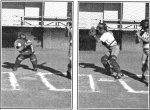
There is a common problem that shows up in catching and in infield play, especially on bunt plays and soft ground-balls, to NOT step directly at the throwing target. The player ends up "splay footed" which causes the throwing arm, to drop and throw side-arm. Too often this results in throwing to the RIGHT of the intended target. You CAN throw more accurately side-arm by stepping directly at the target. But the two are not related. Poor footwork can result in side-arm throws which IS the problem. The Czech Republic was in one of the tournaments shown in the Model Fielding videos. This was their biggest problem defensively.
1) Catcher's do this by standing up too high when they rise up out of their squat.
2) They swing their right leg all the way behind the left foot, causing their weight balance to go behind them too much.
The step with the left foot then extends, not directly forward, but opens up stepping to the left side several inches.
The arm slot drops, and the ball sails toward right field.
If you think about it, 95% of the bad throws by the catcher are toward the RF side. It isn't automatic, but happens too often.
The main thing for catchers that creates this flaw is the big swing of the right leg back behind too far, instead of to the center-line.
The cure for this is for fielders and catchers to work with awareness to step directly at the intended target.
For catchers, there are two points: First is bring the right foot back TO the center-line, that splits the feet, right below the belly-button. The second step with the left foot is then forward, and to the right, onto the center-line. Two steps complete the body rotation like a quarter circle.
Second, don't swing the glove around in a circle, but bring it in a straight line back to the ear, palm down, elbow up. The photos included here show a girl with her belly-button over the center of the plate. This was just for demonstration sake! After the catch, she kicked all the way over, behind her left foot. Her next step was on the batter's box chalk-line. The elbow almost certainly will now drop, and the throw may well be toward RF and off target.
Click to enlarge!

Last edited:
Thanks for the replies thus far. Steve, I think your explanation of the initial step with the right foot being too long is the likely cause in her case. Other than consciously limiting the size of the initial step with the right foot, are there any specific drills that might be helpful?
Greenmonsters
Wannabe Duck Boat Owner
Check out this link to the New England Catching Camp website for a review of the throwing and footwork techniques Throw to 2nd | The New England Catching Camp
You;ll find a number of excellent posts on here by Coach Jay (as CCJr) and his late father Dave (Catching Coach). The NECC $40 video remains the best SB investment I've made. Get a copy if your DD is serious about catching.
You;ll find a number of excellent posts on here by Coach Jay (as CCJr) and his late father Dave (Catching Coach). The NECC $40 video remains the best SB investment I've made. Get a copy if your DD is serious about catching.
Thanks for the replies thus far. Steve, I think your explanation of the initial step with the right foot being too long is the likely cause in her case. Other than consciously limiting the size of the initial step with the right foot, are there any specific drills that might be helpful?
Well there are some obstacle drills you can do. You can put something between her feet that she can in essence squat over. The right foot comes around behind it and the left foot swings forward in front of it. This will help her balance by not moving. A lawn-mover tire or some other similar sized object might work.
The next thing I would do is use one of those "pool noodles". Look at the photos above. The catcher's legs aren't straight, and shouldn't be. Stand behind her and hold the noodle at a height that is just above an appropriate height for her to rise up. Is she touches it, she gets the feed-back.
Combine these with a string drill, in that you run a string from post to post (big spike) right between her feet. The instep of her right foot should be on the string, and the ball of the left (front) foot should also be on the string when she finishes her steps.
Here are two videos that I found. Ashley Holcombe does these skills more like my technique than anyone else. However, I don't like the weight on the balls of the feet as she discusses. This causes the weight to have to shift up slightly before the drop to block pitches in the dirt. I also don't like the baseball technique of a wider stance with runners on. I am trying to get a video here from Europe where I taught some specifics. But if you put your knees and weight as with Holcombe, but the weight on the entire insides of the feet, not just balls, you kick back the feet, NOT DROP, NOT RISE UP AND DROP, and the blocking position is assumed much faster. I see these catchers all the time assuming the position right before the ball gets to them, or just after the ball gets to them. My technique is much faster! The added benefit, is that when you literally kick the feet backward, the feet are brought together in a triangle behind the catchers crotch or glove. Anything that gets under or around the glove is blocked by the legs and feet behind them. Everything else Ashley does is the same.
Cathing Tips-Stance with Ashley Holcombe USA Softball - YouTube
Catching Tips-Throwing with Ashley Holcombe USA Softball - YouTube
However, one footnote here. I don't have my catchers dive out to the side to block pitches, but that can only be adequately demonstrated with video. In fact, when my catchers move to the side to block, they automatically stand up after blocking the ball. They can't prevent standing up! So they can go retrieve the blocked pitch in any direction without scrambling to their feet. I hesitate to place these photos because they are what NOT to do, rather than what to do! I can't open the good photos because of their format or corruption to the folder. Later I will have a video of what is right to do!
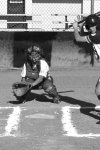
"BAD TARGET". In this photo the target is across the body and the ball will be carried away from the strike zone when caught. It also creates a greater distance to move to block pitches in the dirt. I disagree vehemently with coaches who say the catcher shouldn't move, unless you don't plan on coaching past Little League. The ball should be caught in the center of the body.
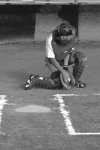
"HAND IN GLOVE" This photo shows the "to the side blocking technique" but poorly; hand and knee! The lead foot strides out beyond the wild pitch, which is facilitated by the weight on the inside edges of the feet. It is a push-off to the side down the baseline. The back knee cap MUST strike the heel of the front foot. This forces two things. It rotates the chest toward the pitcher, or pitch, keeping the ball in front, and lastly, it forces the catcher to stand up! I repeat, it FORCES the catcher to stand up after the ball is blocked, to move quickly to retrieve the ball. Lastly, what is that hand doing in the glove?
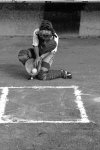
Same as last photo. Hand in glove and knee missed the back of the lead foot again.
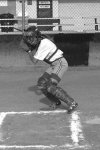
"STAND UP". The force of the back knee cap against the heel forces the catcher to rise up.
Last edited:
"Heals are on the ground, toes pointed up the lines."
"Throwing hand is behind glove."
"Proper position for throwing hand is as follows. Player extends hand as if to offer handshake. Drop thumb to palm, wrap fingers around to protect thumb. Then the hand is placed behind glove with the middle finger knuckles touching glove."
"Catcher has come up in crouch so thighs are parallel to ground. This is approx. Goal is to get out of deep crouch and 'unlock hips' to allow for a quick explosive move towards second. Staying in deep crouch requires first move to be “up” and that will waste time."
I read this article by New England Catching Camp and it is excellent in my opinion. Of course I doubted before-hand I would disagree with much anyway.
Throw to 2nd | The New England Catching Camp
There a three differences: 1) I like Holcombe's knee and weight position in her video, except that I prefer the weight on the entire inside-edge of the feet, rather than the balls of the feet. 2) This creates a quicker drop to block and the kickback also brings the legs together in a triangle behind the glove. 3) Blocking to the side isn't a dive out, but a "step out" to the side, shoulders facing the pitcher or pitch, hand behind the glove as normal, and the automatic stand-up. This creates a greater range in blocking pitches and makes the catcher quicker to the ball. It also helps keep more uncommitted runners from advancing.
"Throwing hand is behind glove."
"Proper position for throwing hand is as follows. Player extends hand as if to offer handshake. Drop thumb to palm, wrap fingers around to protect thumb. Then the hand is placed behind glove with the middle finger knuckles touching glove."
"Catcher has come up in crouch so thighs are parallel to ground. This is approx. Goal is to get out of deep crouch and 'unlock hips' to allow for a quick explosive move towards second. Staying in deep crouch requires first move to be “up” and that will waste time."
I read this article by New England Catching Camp and it is excellent in my opinion. Of course I doubted before-hand I would disagree with much anyway.
Throw to 2nd | The New England Catching Camp
There a three differences: 1) I like Holcombe's knee and weight position in her video, except that I prefer the weight on the entire inside-edge of the feet, rather than the balls of the feet. 2) This creates a quicker drop to block and the kickback also brings the legs together in a triangle behind the glove. 3) Blocking to the side isn't a dive out, but a "step out" to the side, shoulders facing the pitcher or pitch, hand behind the glove as normal, and the automatic stand-up. This creates a greater range in blocking pitches and makes the catcher quicker to the ball. It also helps keep more uncommitted runners from advancing.
Last edited:
Similar threads
- Replies
- 11
- Views
- 10K
- Replies
- 26
- Views
- 16K
- Replies
- 0
- Views
- 3K
- Replies
- 0
- Views
- 3K



